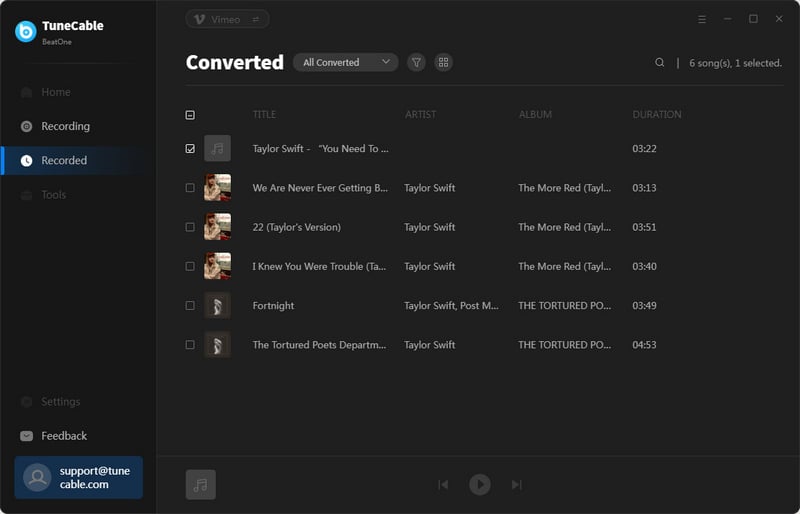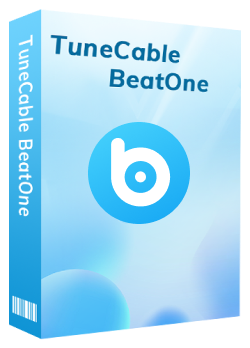Step-by-Step Guide on How to Use TuneCable Beatone
TuneCable Beatone aids users in retrieving audio content from various platforms and transforming it into standard formats. Let us nail down the detailed steps involved in converting music from a multitude of streaming services.
Directory
Part 1. How to Register TuneCable BeatOne?
Note: Should you have not yet downloaded this TuneCable BeatOne, kindly click the button below to install instantly.
Step 1. You need to select a music source on the main interface, then you will find the "menu" button in the top right. Click it to unfold the menu list, tap on "Register". Another option is to click on the "Register" button in the lower left of the sidebar.
Step 2. After the purcahse, you will receive emails including a license. Copy and paste the registration Email and Code into the registration box, and tap on the "Register" button to activate the license.

Note: The registration info is case-sensitive. And, please do not add a blank at the beginning or the end of the word.
Part 2: How to Use TuneCable BeatOne
TuneCable BeatOne retrieves music from a variety of sources using three distinct methods. The details are as follows:
- Download music from the App: Spotify, iTunes/Apple Music, Amazon Music, Tidal.
- Download music from the Web player: Spotify, Apple Music, Amazon Music, Tidal, YouTube Music, Line Music, Pandora.
- Download music from the Website: Audible, Dailymotion, Veoh, YouTube, Vimeo, SoundCloud, and more websites by manually inputting URLs.
Let's follow the detailed instructions to download music via differents methods.
Part 2.1: Download Music from the Music App
Step 1: Select Music Cource
After the installation of TuneCable BeatOne, launch it on your computer. On the primary interface, top music streaming music platforms are displayed.
If you are inclined to high-quality music extraction, you can download music from the app. When recording music from Spotify, Apple Music/iTunes, Amazon Music, and Tidal Music, you are allowed to extract songs from the app.
We take Tidal Music as an example. Click on the "Tidal App" tag on the primary interface. If you see "Tidal Web Player", click the "switch" ![]() button in the upper right to flip to "Tidal App".
button in the upper right to flip to "Tidal App".
After that, the pre-installed Tidal Music app will pop up. Log into Tidal Music with a free or paid plan. A free account is feasible to download music via TuneCable if the streaming music platform offers a free plan for the audience.

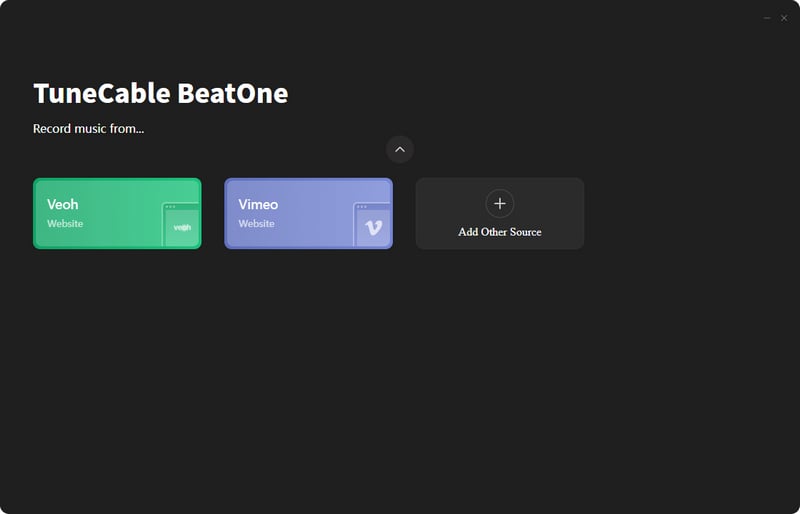
Step 2: Customize Output Settings
In the left sidebar, go to the "Settings" button. Select the options you prefer and the changes will be applied automatically.
Under the "Convert Settings", you are allowed to change the options of "Conversion Mode", "Output Format", "Bit Rate ", "Sample Rate", and "After Converting".
Note:
1. After selecting different output formats, the options for bitrate and sample rate will be different.
2. The "Auto" option in output format can intelligently help export music in original quality and format.
Under the "Output Settings", you are supported to make changes to the "Output Folder", "Output File Name", and "Ouput Organized".
Next, you will see more options for tools. You can customize the "Output Format", "Quality", and "Output Folder".
The general settings include "Appearance", "Languages", "Proxy", etc. Moreover, the advanced setting enables you to add songs from the music app in one-click.
- Conversion Mode: Intelligent Mode, Tidal Record(Change with music source), YouTube Download
- Output Format: Auto, MP3, AAC, WAV, AIFF, ALAC, FLAC
- Bit Rate: 128kbps, 192kbps, 256kbps, 320kbps
- Sample Rate: 44.1kHz, 48kHz, 96kHz, 192kHz
- After Converting: Do nothing, Open the output folder, Put the system to sleep
- Output Folder: To your preference
- Output File Name: Track Number, Title, Artist, Album, Playlist Index, Year
- Output Organized: None, Playlist, Artist, Album, Artist/Album, Album/Artist, Playlist/Artist, Playlist/Album
- Output Format: MP3, AAC, FLAC, WAV, OGG, AIFF
- Quality: 128kbps, 192kbps, 256kbps, 320kbps
- Output Folder: To your preference
![]() Convert Settings:
Convert Settings:
![]() Output Settings:
Output Settings:
![]() Tools:
Tools:
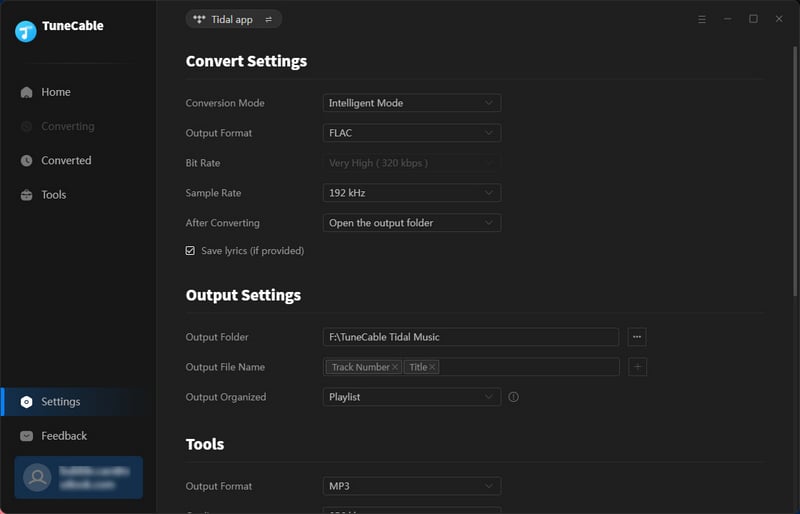
Step 3: Add Music to Queue for Download
Once you finish the settings, go back to "Home". Three methods are feasible to add songs.
▸ 1. Drag or drop a song, album, or playlist from the Tidal app to TuneCable and start parsing.
▸ 2. Right-click the "three dots" icon next to a track, album, or playlist and choose to copy its URL in the pop-up menu. Then you can paste the URL into the TuneCable parse box.
▸ 3. Open a track, album, or playlist, and then tap on the "Click to add" button in the lower right.
TuneCable will list all tracks after parsing the link. Tick off your desired items and click on "Add".
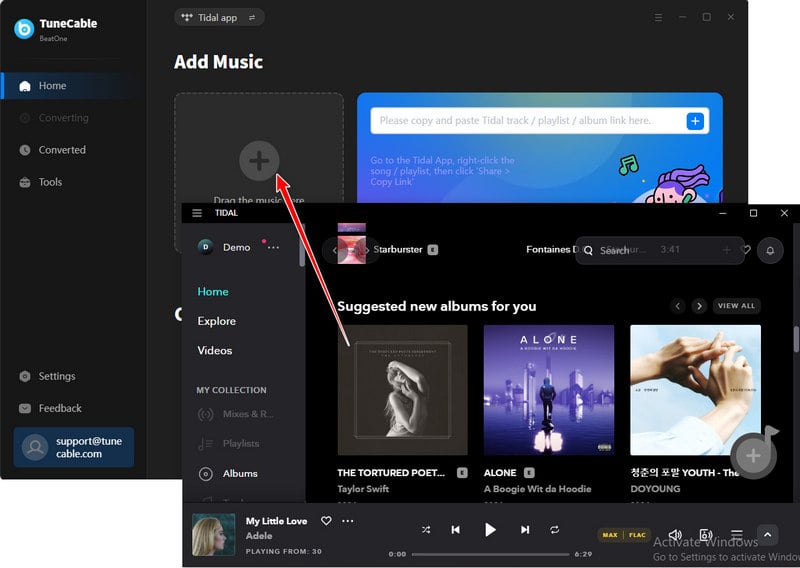
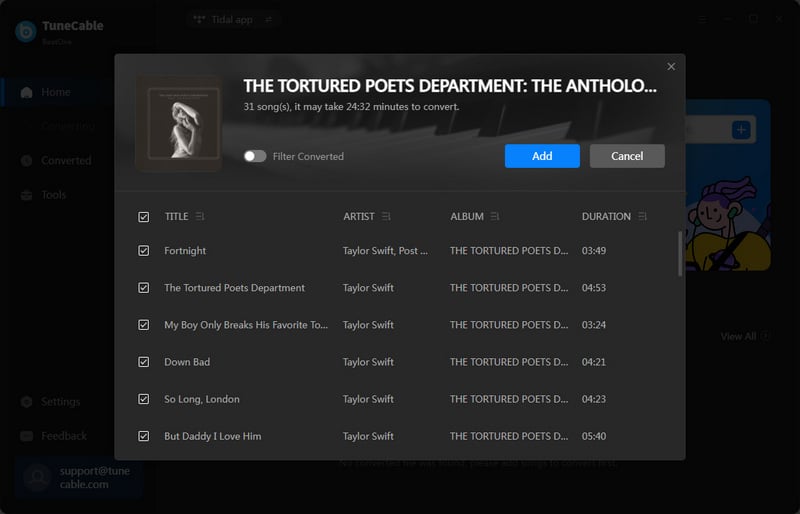
Step 4: Download Music as Local Files
Click on "Add More" if you decide to queue more songs. Hit on the "Convert" button if you quit adding more tracks, albums, or playlists.
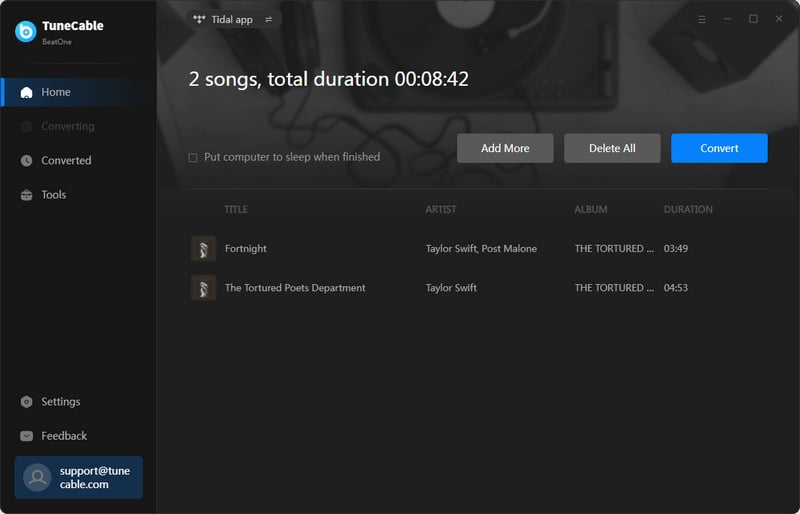
Step 5: Check the Downloaded Music Files
The download history can be checked under the "Converted" column. Moving the pointer cursor to any track and clicking the "folder icon" will orient you to the saving location.
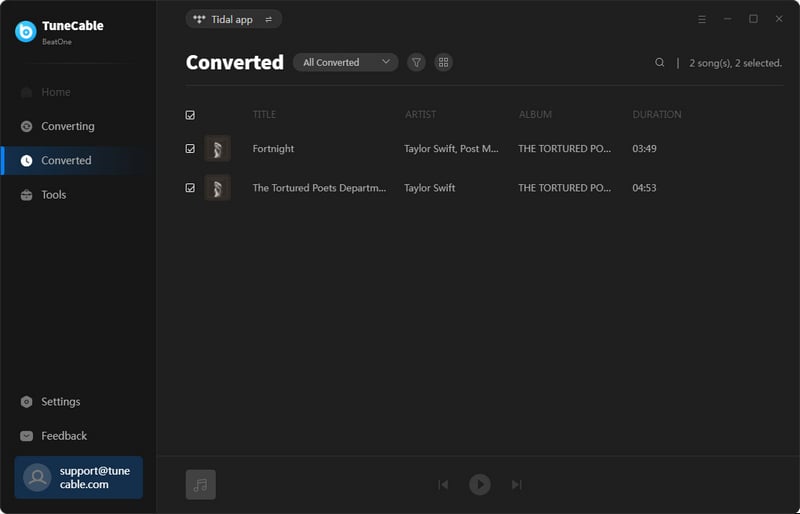
Part 2.2: Download Music from the Web Player
Step 1: Select Music Cource
Once TuneCable BeatOne is installed, open it. Navigate to the music platform you prefer. Extracting music from the built-in web player will enhance the conversion speed to 10x.
For example, we download music from the Tidal web player. Click on the "Tidal Web Player" tag on the primary interface. If you see "Tidal App", click the "switch" ![]() button in the upper right to flip to "Tidal Web Player".
button in the upper right to flip to "Tidal Web Player".
The click will activate the built-in Tidal web player. Sign into Tidal Music with a free or paid plan. A free account is viable for downloading music through TuneCable, provided the streaming platform extends a no-cost subscription option to its users.
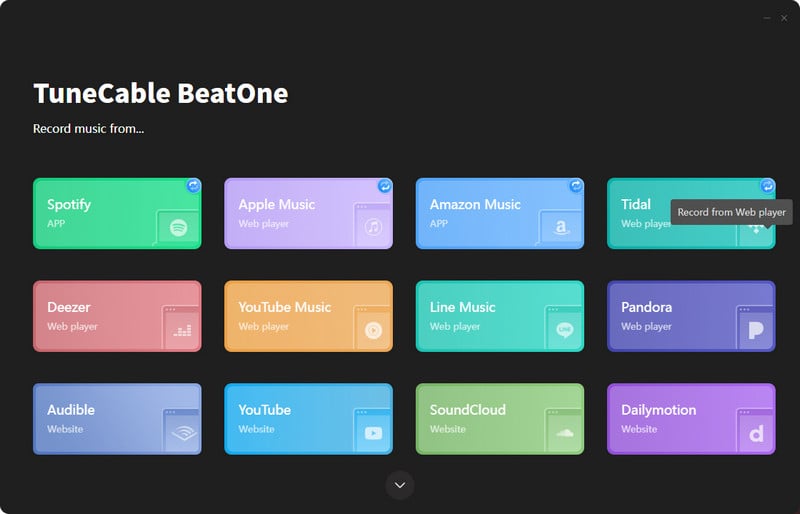
Step 2: Customize Output Settings
In the "Settings" section, the output parameters can be customized. Check all options and pick your preferred output format, bit rate, sample rate, etc.
If you select "Auto" in the Output format setting, TuneCable will download the audio files in the pristine quality and format automatically.
- Conversion Mode: Intelligent Mode, Web Download, YouTube Download
- Output Format: Auto, MP3, AAC, WAV, AIFF, ALAC, FLAC
- Bit Rate: 128kbps, 192kbps, 256kbps, 320kbps
- Sample Rate: 44.1kHz, 48kHz, 96kHz, 192kHz
- After Converting: Do nothing, Open the output folder, Put the system to sleep
- Output Folder: To your preference
- Output File Name: Track Number, Title, Artist, Album, Playlist Index, Year
- Output Organized: None, Playlist, Artist, Album, Artist/Album, Album/Artist, Playlist/Artist, Playlist/Album
- Output Format: MP3, AAC, FLAC, WAV, OGG, AIFF
- Quality: 128kbps, 192kbps, 256kbps, 320kbps
- Output Folder: To your preference
![]() Convert Settings:
Convert Settings:
![]() Output Settings:
Output Settings:
![]() Tools:
Tools:
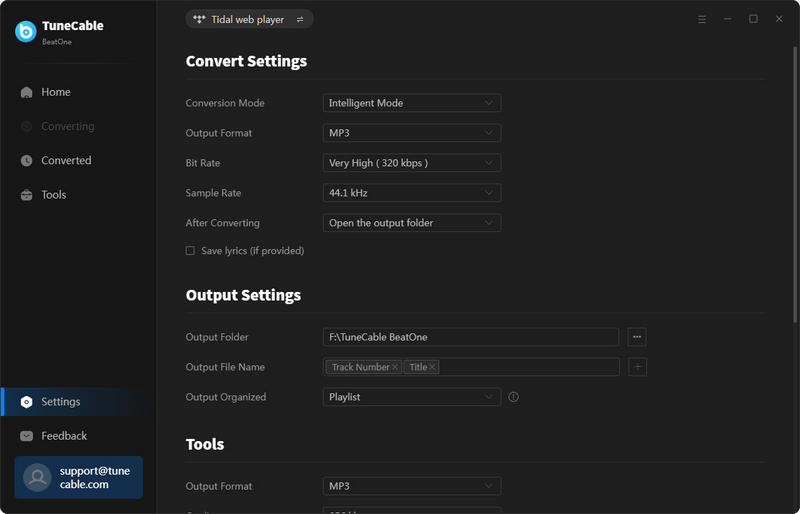
Step 3: Add Music to Queue for Download
After you finish the settings, return to "Home". Browse for a desired song, album, or playlist and click on its title. From its detailed page, go to the lower right, and hit on the "Click to Add" button to load the songs.
Choose the tracks you need and tap on the "Add" button to queue them for download.
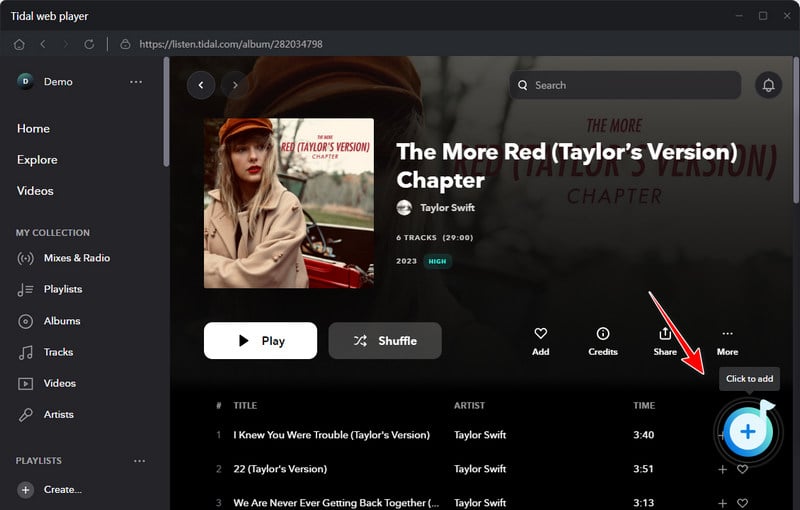
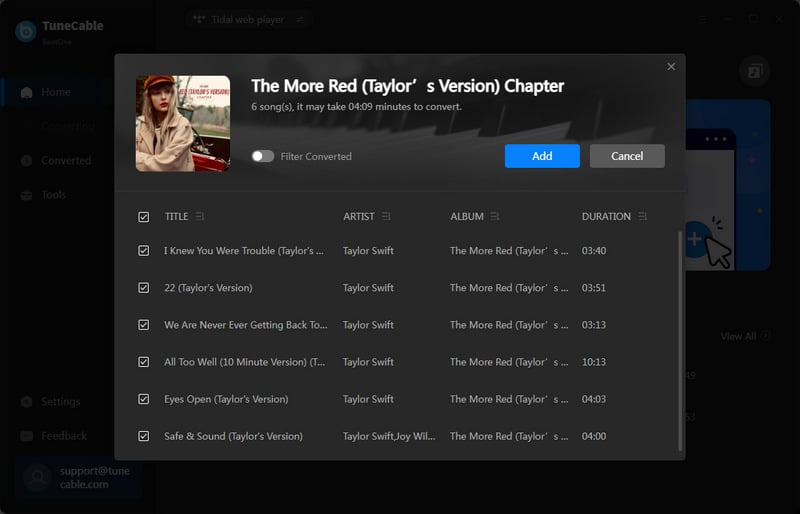
Step 4: Download Music as Local Files
When you are thinking about downloading more tracks in bulk, click on "Add More". When you are about to excute an instant conversion, hit on the "Convert" button
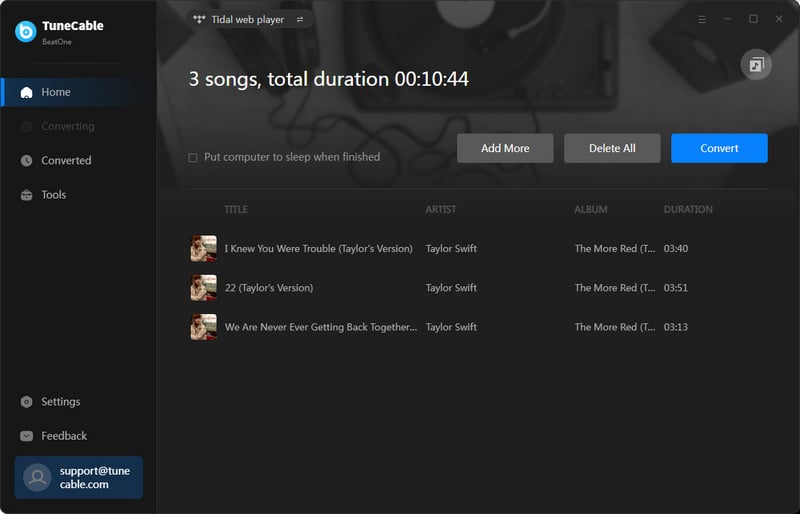
Step 5: Check the Downloaded Music Files
When the conversion completes, go to the "Converted" column to check the download history. The "folder icon" next to each track will navigate you to the its output folder.
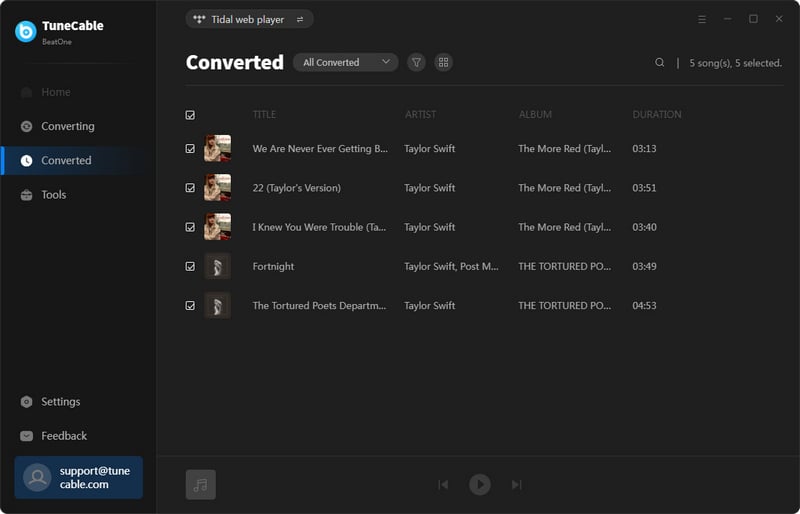
Part 2.3: Download Music from the Website
Step 1: Select Music Cource or Add Custom Website
Start TuneCable BeatOne after the installation. On the start-up interface, navigate to Audible, Dailymotion, Veoh, YouTube, Vimeo, or SoundCloud.
If you could not find the wanted platform, scroll down to the next page and click on "Add Other Source". Input a name and URL to generate a custom entry.
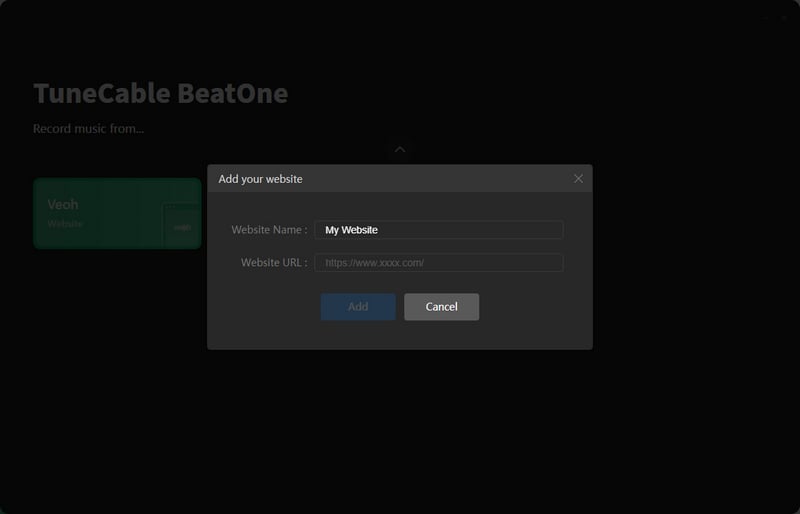
Let's take Vimeo as an example. Click "Vimeo Website" to activate the embedded Vimeo Website. Find your wanted tracks in the Vimeo Website.

Step 2: Customize the Output Settings
In the "Home" page, you are allowed to alter the "Ouput Format" and "Bit Rate". Additionally, according to your specific requirements, you may opt to enable the software's automatic detection of playing audio, accompanied by selected processing tasks such as automated trimming of lengthy recordings, filtration of excessively brief clips, or programming it to cease recording upon reaching a predetermined duration. Simply mark the checkboxes corresponding to your desired choices.
If you need take more changes to the output parameters, go to the "Settings" section.
- Output Format: Auto, MP3, AAC, WAV, AIFF, ALAC, FLAC
- Quality: 128kbps, 192kbps, 256kbps, 320kbps
- Output Folder: To your preference
- Output File Name: Track Number, Title, Artist, Album, Playlist Index, Year
- Output Organized: None, Playlist, Artist, Album, Artist/Album, Album/Artist, Playlist/Artist, Playlist/Album
- Output Format: MP3, AAC, FLAC, WAV, OGG, AIFF
- Quality: 128kbps, 192kbps, 256kbps, 320kbps
- Output Folder: To your preference
![]() Record Settings:
Record Settings:
![]() Output Settings:
Output Settings:
![]() Tools:
Tools:
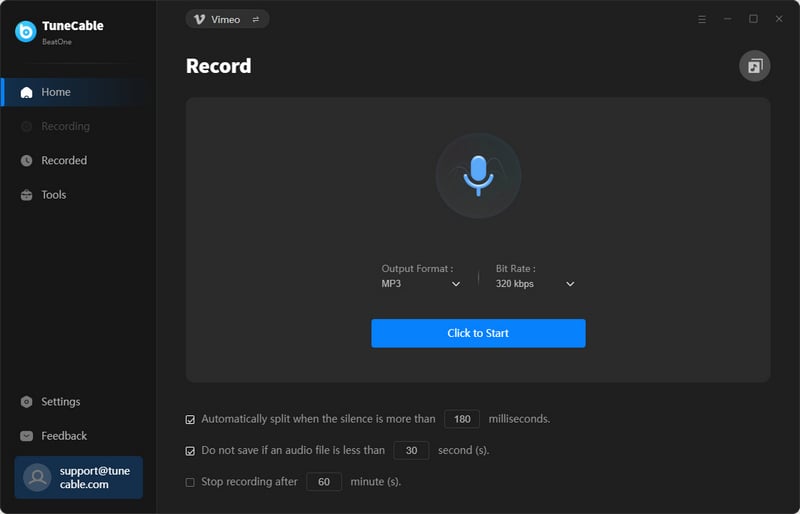
Step 3: Start Recording Music
Please log in to your account and open the music you wish to record. Subsequently, initiate the recording by clicking the blue "Click to Start" button on the main interface. Upon completion of the recording, click "Stop". The recorded song will then be automatically saved to the output path you have designated.
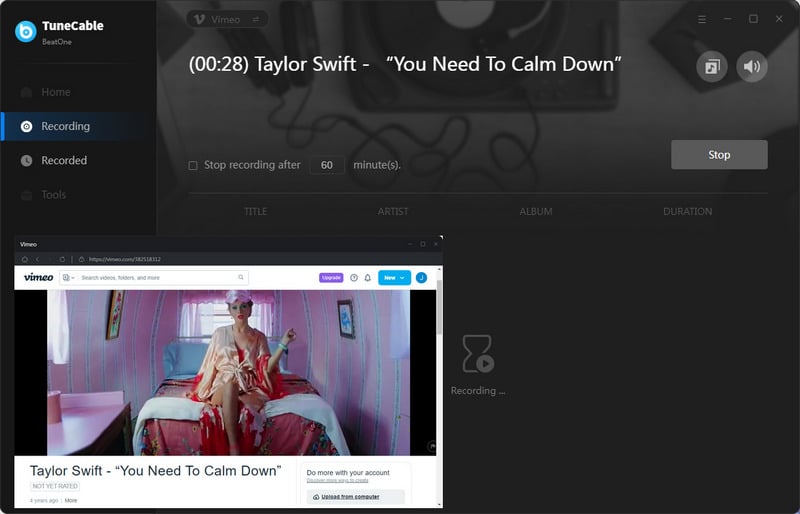
Step 4: Check the Downloaded Music Files
Upon completion of the conversion, navigate to the "Recorded" tab to view your download history. The "folder icon" adjacent to each track will guide you to its respective output folder.
